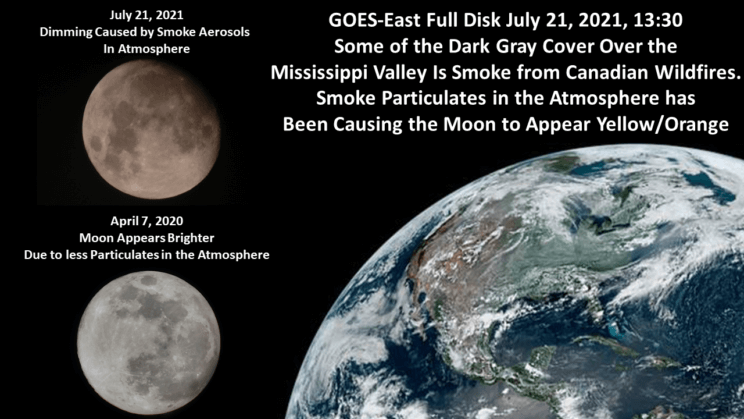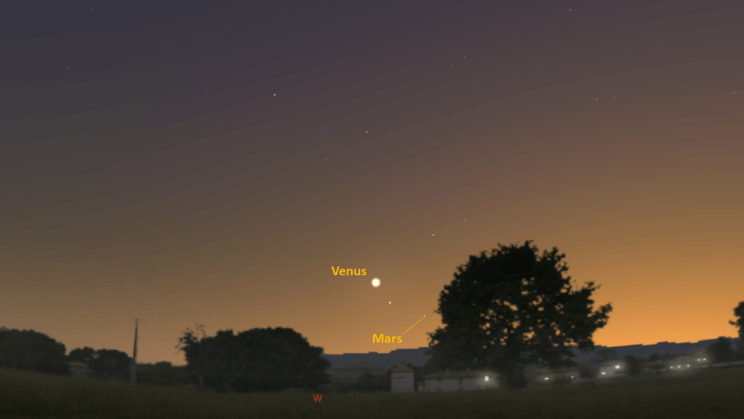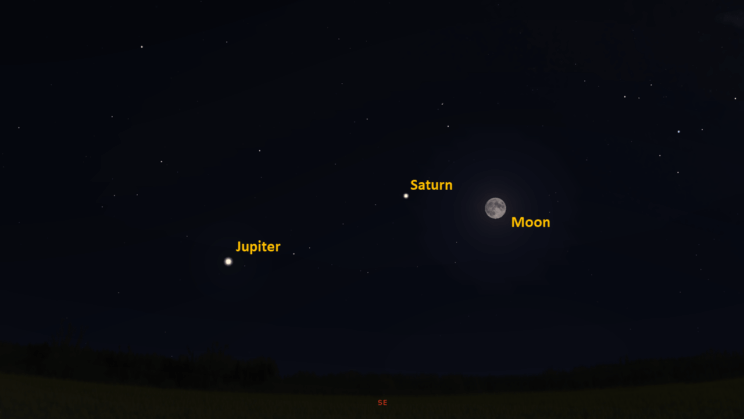This is the Saint Louis Science Center’s NIGHT SKY UPDATE for the week of Friday, July 23, 2021.
Information updated weekly or as needed.
Times given as local St. Louis time, which is Central Daylight Time (CDT). For definitions of terminology used in the night sky update, click the highlighted text. If relying on times posted in Universal Time (UT), St. Louis is -5 hours when CDT.
Public Telescope Viewings
With the changing recommendations from the CDC regarding COVID-19, conversations regarding the return of star parties at the Saint Louis Science Center have begun. We are close to bringing back our public telescope viewings, but a few details still need to be worked out. We will post future updates as we learn more about when we can bring back telescope viewings.
Observing Highlight of the Week

Smoke from Canadian wildfires has been causing the Moon to appear yellow/orange
GOES Image Credit: NOAA/STAR; Moon Image Credit: Eric Gustafson
This week’s highlight is more of a lowlight. If you have been out to observe over the last week, you probably noticed there has not been much to see in the sky over the Greater St. Louis area. Aside from our normal issues with light pollution, there has been another complication. Scanning the horizon during daytime is a good way to get a measure of the levels of aerosols and other pollutants hanging around. On bad days, the sky along the horizon will appear hazy. If you notice this haziness during the day, it is a good prediction of what viewing conditions will be at night. Aside from air pollutants, high humidity can also lead to days where the sky appears hazy. Keep in mind that the objects we observe at night are seen after their light passes through the atmosphere. Everything we see is slightly distorted depending on the state of the atmosphere.
Due to larger particle size, many common pollutants such as aerosols effectively scatter all wavelengths of visible light. This is known as Mie Scattering, which is the same reason clouds look white. The horizon will look hazy due to the Mie Scattering caused by air pollutants.
Another way to estimate the air quality or atmospheric conditions is to note how blue the sky appears. If the sky looks to be dominantly blue, then conditions are relatively good. If the color is leaning towards whitish blue, then conditions are not great. The whiter the blue appears the worse viewing conditions will be. Interpreting these conditions is also beneficial for those that deal with respiratory issues. If you are curious about how air quality can impact our respiratory system, I would encourage you to read about the Air Quality Index. Those roadside signs that color code air quality are forecasts based on the Air Quality Index. You can learn more about this system at https://www.airnow.gov/aqi/aqi-basics/
Switching our focus to nighttime, atmospheric conditions will impact the colors we see during sunset. The normal pastel colors we see can turn to fiery orange, pink and purple sunsets due to aerosols from volcanic eruptions and wildfires. If air pollution is bad, the colors we see can appear as a muted brown. Observing the colors of sunset is a great way to get a measure of what viewing conditions will be. Keep in mind, atmospheric conditions change all the time. Conditions that appear good early in the night might change drastically as you observe.
Finally, the reason I wanted to explore atmospheric conditions this week is due to the Moon’s appearance. Last week, the Moon appeared dimmer than it normally would near full moon. Additionally, only the brightest stars could be seen. This is caused by smoke passing overhead from Canadian wildfires. It can be surprising to find out how something happening far away can impact conditions where you live. The smoke from Canadian wildfires has not had a large impact on St. Louis, but it did lead to the Moon appearing yellow/orange all night long. Areas in the Dakotas and Minnesota experienced conditions that lead to air quality being quite poor. These issues are a great reminder that dangerous weather and climate changes have lasting impacts all over the world.
As wildfires continue in the west, visual reminders such as the colors seen at sunset or the appearance of the Moon are great ways to keep an eye on this. Nature always gives us something interesting to learn about, so keep looking up.
The Sun and Moon

The Moon as seen from the International Space Station, on July 31, 2011.
Credit: NASA
Sunrise is at 5:55 a.m. on Friday, July 23, and sunset is at 8:19 p.m., providing us with about 14.5 hours of daylight. Even after sunset, the light from the Sun will dimly illuminate our sky for a bit under 2 hours. This period is called twilight, which ends around 10:08 p.m. this week. For those with a sundial, local noon occurs around 1:08 p.m. this week.
| Day | Sunrise | Sunset |
|---|---|---|
| 2021-07-23 | 5:55 a.m. | 8:19 p.m. |
| 2021-07-24 | 5:56 a.m. | 8:19 p.m. |
| 2021-07-25 | 5:57 a.m. | 8:18 p.m. |
| 2021-07-26 | 5:58 a.m. | 8:17 p.m. |
| 2021-07-27 | 5:59 a.m. | 8:16 p.m. |
| 2021-07-28 | 6:00 a.m. | 8:15 p.m. |
| 2021-07-29 | 6:00 a.m. | 8:14 p.m. |
| 2021-07-30 | 6:01 a.m. | 8:13 p.m. |
| 2021-07-31 | 6:02 a.m. | 8:12 p.m. |
Moon
Moonrise for Friday, July 23 occurs at 8:33 p.m. and moonset will occur at 6:13 a.m. on the following day. On Friday, July 23 the Moon will be at full moon. July’s full moon is often called the Full thunder Moon.
International Space Station (ISS) Observing

Visible passes of ISS from St. Louis for the week of July 23 occur during evening hours. The best passes this week occur on the evenings of July 29 and 30. Use the table below for information about this and other visible passes this week.
Catch ISS from St. Louis starting Friday, July 23
| Date | Starts | Max. altitude | Ends | |||||||
|---|---|---|---|---|---|---|---|---|---|---|
| Time | Alt. | Az. | Time | Alt. | Az. | Time | Alt. | Az. | ||
| 24 Jul | -1.4 | 23:08:16 | 10 | NNW | 23:10:35 | 20 | NNE | 23:10:35 | 20 | NNE |
| 25 Jul | -1.2 | 22:21:15 | 10 | NNW | 22:23:22 | 15 | NNE | 22:24:45 | 13 | NE |
| 26 Jul | -1.6 | 23:10:02 | 10 | NW | 23:11:54 | 27 | NNW | 23:11:54 | 27 | NNW |
| 27 Jul | -2.3 | 22:22:52 | 10 | NNW | 22:25:52 | 29 | NNE | 22:26:08 | 28 | NE |
| 28 Jul | -1.7 | 21:35:46 | 10 | NNW | 21:38:23 | 21 | NNE | 21:40:25 | 13 | ENE |
| 28 Jul | -1.3 | 23:17:07 | 10 | WNW | 23:13:22 | 21 | WNW | 23:13:22 | 21 | WNW |
| 29 Jul | -1.3 | 20:48:43 | 10 | NNW | 20:50:51 | 16 | NNE | 20:52:59 | 10 | ENE |
| 29 Jul | -3.4 | 22:24:44 | 10 | NW | 22:27:41 | 63 | NNW | 22:27:41 | 63 | NNW |
| 30 Jul | -3.1 | 21:37:29 | 10 | NW | 21:40:45 | 45 | NE | 21:42:02 | 29 | E |
| 31 Jul | -2.3 | 20:50:16 | 10 | NNW | 20:53:18 | 29 | NNE | 20:56:18 | 10 | E |
| 31 Jul | -2.1 | 22:27:04 | 10 | WNW | 22:29:24 | 28 | WSW | 22:29:24 | 28 | WSW |
Magnitude (Mag): The Measure of brightness for a celestial object. The lower the value is, the brighter the object will be.
Altitude (Alt): The angle of a celestial object measured upwards from the observer’s horizon.
Azimuth (Az): The direction of a celestial object, measured clockwise from an observer’s location with north being 0°, east being 90°, south being 180° and west being 270°.
For information about ISS flyovers and other visible satellites, visit www.heavens-above.com
Detailed information regarding all unmanned exploration of our universe, missions past, present, and planned, can be found at Jet Propulsion Laboratories:
The Visible Planets

Looking West, at 8:50 p.m. July 23, 2021
Credit: Stellarium, EG

Looking Southeast, at 11:00 pm, July 23, 2021
Credit: Stellarium, EG
This week, four naked eye planets are visible. Venus and Mars can be found in the west after sunset. Jupiter and Saturn can be found in the southeast by 11:00 p.m.
Venus
Venus is well into another evening apparition. By 8:50 p.m., Venus will be about 12° above the western horizon. As 2021 continues, we will see Venus climb higher in the western sky after sunset until October 29 when it reaches maximum eastern elongation. After this date Venus will start to head back towards the Sun as it approaches inferior conjunction on January 8, 2022.
Mars
Currently Mars appears as a 1.8-magnitude object that will be visible high in the west about 40 minutes after sunset. Mars sets by 9:33 p.m. The viewing window for Mars is getting shorter. Mars is headed towards superior conjunction on October 7, 2021. As we get closer to this date, Mars will set earlier each night until we lose the Red Planet to the glare of the Sun.
Jupiter
Jupiter is now rising before midnight. Jupiter rises at 9:44 p.m. and will be easy to see in the southeast by 10:40 p.m.
Saturn
Saturn has returned to our evening sky. Saturn rises at 8:47 p.m. and will be easy to spot by 10:00 p.m. looking southeast.
James S. McDonnell Planetarium
Night Sky Update: July 23-July 31, 2021






